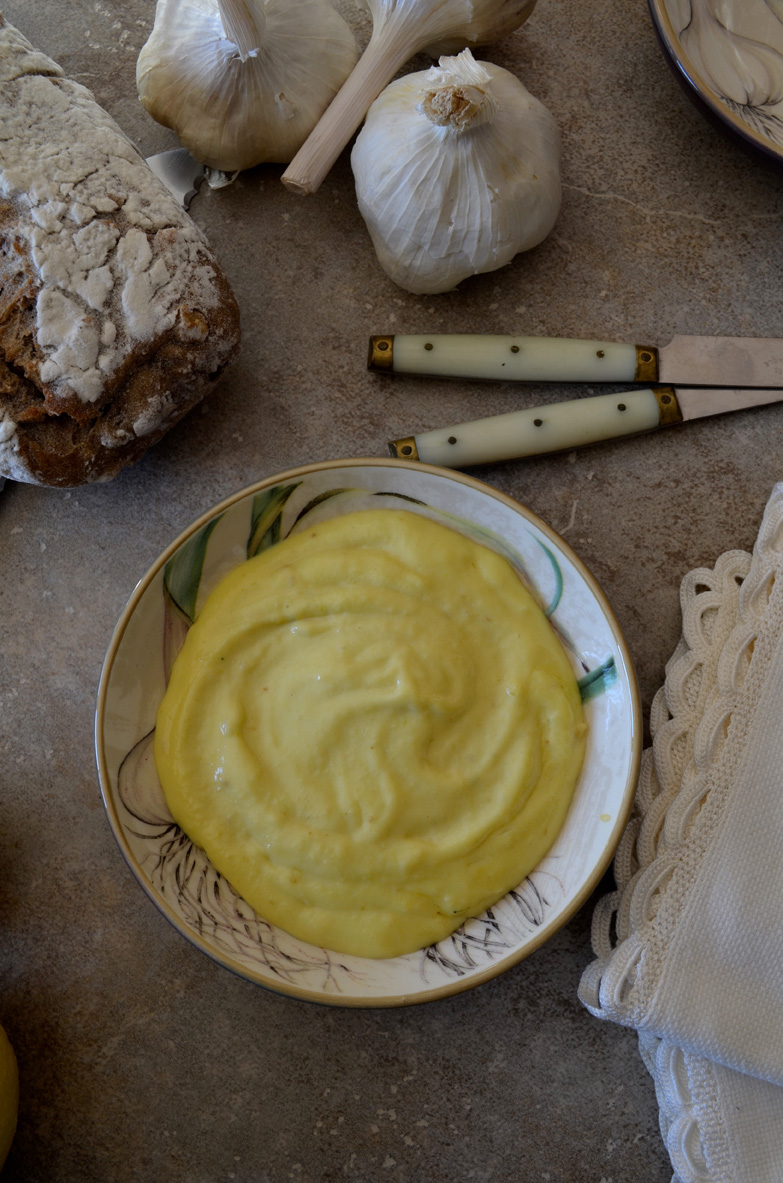Aioli, or Allioli, a versatile sauce
 I can’t believe today is the feast of the Epiphany, Three Kings Day, and I am making allioli while watching the Three Kings Parade on Spanish television. But these are Matthew’s last few days at home before he returns to college, and he wants to have homey, special dishes before he leaves, like the seafood paella I’ll be making later. Besides, let’s face it, as big a holiday as Three Kings is in Spain, with children receiving the visit tonight of their majesties kings Melchor, Gaspar and Baltazar with their presents, we don’t celebrate Three Kings Day in the United States. At our house in Fort Wayne, the celebration depends on the calendar: if January 6 falls on a weekend, we celebrate with roscón (the typical sweet eaten on this day). If it falls during the week, and school is in session, the feast is smaller. The Three Kings, however, stop at our house every year.
I can’t believe today is the feast of the Epiphany, Three Kings Day, and I am making allioli while watching the Three Kings Parade on Spanish television. But these are Matthew’s last few days at home before he returns to college, and he wants to have homey, special dishes before he leaves, like the seafood paella I’ll be making later. Besides, let’s face it, as big a holiday as Three Kings is in Spain, with children receiving the visit tonight of their majesties kings Melchor, Gaspar and Baltazar with their presents, we don’t celebrate Three Kings Day in the United States. At our house in Fort Wayne, the celebration depends on the calendar: if January 6 falls on a weekend, we celebrate with roscón (the typical sweet eaten on this day). If it falls during the week, and school is in session, the feast is smaller. The Three Kings, however, stop at our house every year.





I won’t elaborate on the feast of the Three Kings, but I will leave you with a link, of a children’s story I wrote for Highlights for Children magazine a few years ago (click here to read and hear the story). There I explain more about the celebration.
So back to the allioli.
My earliest memory of allioli is the image of my grandma making circles with a pestle in her marble mortar with one hand while, with her other hand, pouring her home-pressed olive oil from a glass container, in a very thin stream. My next memory is that of savoring the garlicky cream on toast. My mom made allioli using an immersion blender, but the results were just as delicious.




Allioli is a garlicky mayonnaise-like sauce that accompanies many rice dishes in the Valencian region, and a number of other dishes in the rest of Spain. The word allioli is a combination of the Valencian language words all (garlic) i (and) oli (oil). In the Castilian speaking regions of Spain it can be spelled with just one “l”, as in alioli, or even by its translation, ajoaceite. The most basic allioli contains only the two ingredients, garlic and olive oil, but I grew up eating allioli containing egg and a bit of vinegar or lemon as well. The recipe I’m sharing is a variation of the traditional, treating the garlic three different ways, making for a much smoother allioli.
¡Feliz Día de Reyes! Happy Three Kings Day!



The Adoration of Baby Jesus, Alcoy, Spain (*)
AIOLI
All i Oli (Valencian) or Ajoaceite (Castilian Spanish)
Ingredients:
14 cloves of garlic
1 egg yolk
1 pinch salt
1 Tbs juice of a lemon
About 1 cup olive oil
The traditional way of making aioli is with a mortar and pestle, but as much as I like using them, this is one of those recipes where I prefer to use a hand or immersion blender.
To reduce the pungent flavor of the garlic, I follow chef M. Carmen Vélez’s tip to treat the cloves in this manner: 1 small clove will remain raw; 4 cloves will be blanched in boiling water for about 2 minutes. The remaining garlic cloves will be caramelized: cook them in 1/4 cup olive oil over low heat, turning them every 2 minutes or so, until soft and almost translucent. Remove the sauté pan from the heat source and let the garlic cloves cool in the oil. After removing the caramelized garlic cloves, save this very aromatic garlic-infused olive oil to use in other recipes.
In a blending cup, or in a tall container not much wider that the width of the head of the immersion blender, add all the garlic cloves, a pinch of salt and the lemon juice. Immerse a hand blender and blend until smooth. Add the egg yolk and blend again until very smooth and well blended. Slowly add the oil in a very slow stream, incorporating it into the sauce without stopping the blender. Use an up-and-down hand motion, while maintaining the running blades always in contact with the sauce. The aioli should reach a consistency just slightly thicker than that of mayonnaise.
If using a mortar and pestle:
Add the first four ingredients in the same order as if you were using the immersion blender. Always stirring with the pestle in the same direction, add the olive oil in a very slow stream until completely incorporated.
When the right consistency is reached, pour in a bowl and refrigerate, covered, until ready to use. Aioli should be consumed no later than after 2 days, and never be left outside of the fridge longer than the duration of the meal when it will be consumed.
Aioli marries well with fish and with rices containing fish, as well as with potatoes, and also simply by itself on grilled slices of bread. It is very versatile, and I’m sure you’ll find many more uses for it.

(*) Photo courtesy of the Tourism Department of the City Council of Alcoy, Spain.


